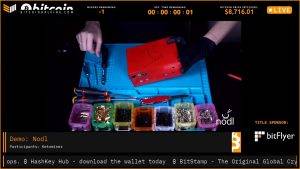The rapid growth of the Internet of Things (IoT) has led to a massive increase in the number of connected devices, ranging from smart home appliances to industrial sensors. However, managing the identities and security of these devices has become a significant challenge. Traditional identity management systems are often centralized, vulnerable to hacking, and lack interoperability. In this article, we will explore the concept of blockchain-based identity management for IoT devices, its advantages, implementation, and potential applications.
Introduction
The advent of blockchain technology has brought forth innovative solutions to various industries, and IoT is no exception. Blockchain-based identity management for IoT devices involves leveraging the decentralized nature of blockchain to establish secure, immutable, and tamper-proof identities for each device. This ensures that only authorized devices can communicate and share data within the IoT ecosystem.
Understanding IoT Devices and Identity Management Challenges
Before diving deeper into blockchain-based identity management, it’s essential to understand IoT devices and the challenges associated with their identity management. IoT devices are physical objects embedded with sensors, software, and connectivity capabilities to collect and exchange data over the internet. They play a crucial role in various domains, including healthcare, agriculture, transportation, and smart cities.
However, traditional identity management approaches struggle to cope with the unique characteristics of IoT devices. These challenges include device heterogeneity, scalability issues, lack of standardized protocols, and security vulnerabilities. Centralized identity management systems are prone to single points of failure, making them attractive targets for cybercriminals. Moreover, managing and updating device identities at scale becomes an arduous task.
The Role of Blockchain in IoT Identity Management
Blockchain technology, originally introduced for cryptocurrencies like Bitcoin, has emerged as a powerful solution for decentralized and secure data management. It operates as a distributed ledger, where multiple participants maintain and validate transactions. The key features of blockchain, such as immutability, transparency, and consensus mechanisms, make it well-suited for IoT identity management.
By leveraging blockchain, IoT devices can have unique identities stored on the distributed ledger. These identities are cryptographically secured and tamper-proof, mitigating the risk of identity theft and unauthorized access. The decentralized nature of blockchain eliminates the need for a central authority, reducing the vulnerability of identity management systems.
Key Components of Blockchain-based Identity Management for IoT Devices

Implementing blockchain-based identity management involves several key components that work together to establish a secure and scalable ecosystem for IoT devices.
1. Identity Creation and Registration
To participate in the blockchain-based identity management system, IoT devices need to generate their unique identities. These identities are created through cryptographic algorithms, such as public-private key pairs. During the registration process, devices provide necessary information and undergo verification to ensure authenticity and integrity.
2. Decentralized Identity Verification
Verification is a crucial step in ensuring that only authorized devices can join the IoT network. Blockchain-based identity management systems leverage consensus algorithms and smart contracts to validate device identities without relying on a centralized authority. This decentralized approach enhances the security and trustworthiness of the system.
3. Secure Communication Protocols
IoT devices communicate with each other and external systems, necessitating secure and encrypted channels. Blockchain-based identity management can facilitate the establishment of secure communication protocols, leveraging cryptographic keys associated with device identities. This ensures confidentiality and integrity during data transmission.
4. Access Control and Permissions
Controlling access to resources and data is essential in IoT environments. Blockchain-based identity management systems enable granular access control mechanisms, where device identities are linked to specific permissions and privileges. This ensures that only authorized devices can interact with specific services or data sources.
Implementing Blockchain-based Identity Management for IoT Devices
To implement blockchain-based identity management for IoT devices, several considerations need to be taken into account.
1. Selecting the Right Blockchain Platform
Different blockchain platforms offer varying features and capabilities. It’s crucial to select a platform that aligns with the specific requirements of IoT identity management, such as scalability, privacy, and smart contract support. Popular blockchain platforms like Ethereum, Hyperledger Fabric, and IOTA have gained traction in the IoT domain.
2. Integration with IoT Devices
Integrating blockchain with IoT devices involves the development of appropriate software libraries and protocols. IoT devices need to be capable of generating and managing cryptographic keys, interacting with blockchain networks, and securely communicating with other devices.
3. Ensuring Privacy and Security
Privacy and security are paramount when dealing with IoT devices. Blockchain-based identity management should prioritize data privacy and employ encryption techniques to safeguard sensitive information. Additionally, implementing robust security measures, such as secure bootstrapping, firmware integrity checks, and intrusion detection, is crucial to protect IoT devices from attacks.
Benefits and Potential Applications
Blockchain-based identity management for IoT devices offers numerous benefits and opens up new possibilities for various industries.
1. Enhanced Security and Data Integrity
By leveraging blockchain technology, IoT devices can have tamper-proof identities, reducing the risk of unauthorized access and data breaches. The immutability of blockchain ensures that device identities remain secure and trustworthy, even in the face of hacking attempts.
2. Streamlined Device Onboarding and Provisioning
Traditional device onboarding and provisioning processes can be cumbersome and time-consuming. With blockchain-based identity management, the process becomes streamlined and automated. Devices can securely authenticate themselves, register their identities, and join the IoT ecosystem seamlessly.
3. Supply Chain Management
Blockchain-based identity management can revolutionize supply chain management by providing end-to-end visibility and traceability. Each device involved in the supply chain can have a unique identity, and its interactions and transactions can be recorded on the blockchain. This enhances transparency, reduces counterfeiting, and enables efficient tracking of goods.
4. Smart Cities and Energy Grids
In smart city deployments and energy grids, blockchain-based identity management can play a crucial role. Devices, such as smart meters and sensors, can securely authenticate themselves and communicate with relevant entities. This enables efficient energy management, optimized resource allocation, and improved overall system performance.
Challenges and Limitations
While blockchain-based identity management offers significant advantages, it also faces certain challenges and limitations.
1. Scalability and Performance
Blockchain networks, especially public ones, often struggle with scalability and performance issues. As the number of IoT devices continues to grow exponentially, blockchain-based identity management systems need to address these challenges to handle the increased transaction load and ensure real-time responsiveness.
2. Interoperability with Existing Systems
Many IoT deployments already utilize legacy systems and protocols. Integrating blockchain-based identity management with existing systems can be complex and requires careful consideration of interoperability. Standardization efforts and collaborations across industries are crucial to overcome this challenge.
3. Regulatory and Legal Considerations
Blockchain technology and IoT devices operate within a complex regulatory landscape. Compliance with data protection regulations, such as GDPR, and addressing legal considerations surrounding data ownership and liability are essential for successful implementation. Collaboration between technology providers, regulators, and industry stakeholders is necessary to address these concerns effectively.
Future Outlook and Trends
The future of blockchain-based identity management for IoT devices looks promising, with several trends shaping its evolution.
1. Evolution of Blockchain-based Identity Management
As blockchain technology matures, we can expect further advancements in identity management systems for IoT devices. Scalability solutions, interoperability frameworks, and improved privacy features will drive the evolution of these systems, making them more robust and user-friendly.
2. Integration with Artificial Intelligence and Machine Learning
The integration of blockchain-based identity management with artificial intelligence and machine learning can enhance device authentication, anomaly detection, and predictive maintenance. AI algorithms can leverage the rich data captured by IoT devices and blockchain to provide actionable insights and automate decision-making processes.
3. Standardization Efforts and Collaborations
Standardization efforts and collaborations among industry players, research institutions, and regulatory bodies are critical for the widespread adoption of blockchain-based identity management for IoT devices. These initiatives aim to define common frameworks, protocols, and best practices, ensuring interoperability and addressing regulatory concerns.
Key Components of Blockchain-based Identity Management for IoT Devices
1. Data Encryption and Integrity
To ensure data privacy and integrity, blockchain-based identity management systems employ robust encryption techniques. Each IoT device’s data is encrypted before being stored on the blockchain, making it inaccessible to unauthorized parties. Additionally, the decentralized nature of blockchain prevents data tampering, maintaining the integrity of the information.
2. Immutable Device Identities
Blockchain provides a decentralized and immutable ledger where device identities can be recorded. Each IoT device is assigned a unique identifier that is securely stored on the blockchain. This immutable identity enables reliable device authentication and prevents identity spoofing or unauthorized access attempts.
3. Decentralized Consensus Mechanisms
Consensus mechanisms play a vital role in validating device identities within a blockchain-based identity management system. Through consensus algorithms like proof-of-work or proof-of-stake, the network agrees on the authenticity of device identities, ensuring that only verified devices can participate in the IoT ecosystem.
4. Self-Sovereign Identity
Blockchain-based identity management empowers IoT devices with self-sovereign identity, allowing them to have full control over their identity information. With self-sovereign identity, devices can manage their personal data, selectively share information with other devices or services, and revoke access if necessary. This puts the device owners in control and enhances privacy.
5. Smart Contracts for Access Control
Smart contracts, programmable agreements stored on the blockchain, enable granular access control in blockchain-based identity management systems. Through smart contracts, specific access permissions and rules can be defined, ensuring that only authorized devices or entities can interact with certain resources or services. This fine-grained access control enhances security and reduces the risk of unauthorized data access or manipulation.
Implementing Blockchain-based Identity Management for IoT Devices
1. Selection of Suitable Blockchain Platform
Choosing the right blockchain platform is crucial for successful implementation. Factors such as scalability, transaction speed, consensus mechanism, and community support need to be considered. Ethereum, for example, is a popular choice due to its robustness and smart contract capabilities, while platforms like Hyperledger Fabric offer enterprise-grade features and privacy options.
2. Integration with Existing IoT Infrastructure
Integrating blockchain-based identity management with existing IoT infrastructure requires careful planning and consideration. The system needs to seamlessly interact with IoT devices, protocols, and gateways. APIs and protocols like MQTT, CoAP, or WebSockets can be utilized to enable communication between devices and the blockchain network, ensuring compatibility and interoperability.
3. Secure Key Management
Proper key management is crucial for the security of blockchain-based identity management systems. IoT devices need to generate and securely store their cryptographic keys. Hardware security modules (HSMs) or secure enclaves can be employed to protect these keys from unauthorized access or theft. Regular key rotation and secure key distribution protocols should also be implemented to enhance the system’s overall security.
4. Privacy-Preserving Techniques
Preserving privacy in blockchain-based identity management for IoT devices is essential. Techniques like zero-knowledge proofs, homomorphic encryption, or private channels can be utilized to ensure that sensitive information remains confidential while still allowing for necessary interactions and verifications. Privacy-enhancing technologies strike a balance between data protection and the transparency benefits of the blockchain.
5. Integration with Identity Providers
Integrating with existing identity providers can enhance the usability and adoption of blockchain-based identity management systems. Leveraging OAuth or OpenID Connect protocols, IoT devices can interact with trusted identity providers to verify user identities and enable seamless authentication and authorization processes. This integration ensures compatibility with established identity frameworks and simplifies user management.
Conclusion
Blockchain-based identity management provides a robust solution to the challenges faced by traditional identity management systems in the IoT domain. By leveraging the decentralization, immutability, and transparency of blockchain, IoT devices can establish secure identities, enhance data integrity, and enable new applications across industries. However, addressing scalability, interoperability, and regulatory considerations remains crucial for the widespread adoption of this technology.









